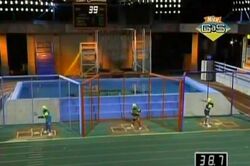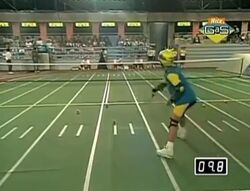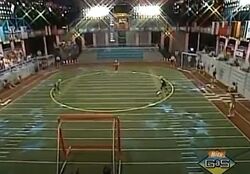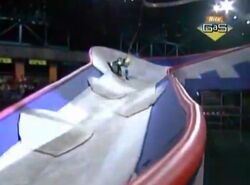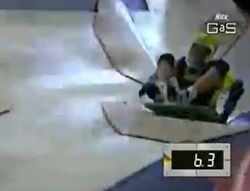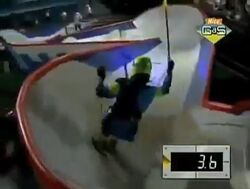This show has a wiki of its own: Nickelodeon GUTS Wiki.
Nickelodeon GUTS (later renamed Nickelodeon Global GUTS) is an American "action-sports" game show that aired for four seasons on Nickelodeon from 1992 to 1995. Mike O'Malley presided as host, and British actress Moira Quirk (often called "Mo") was the referee. The show was taped at Universal Studios Florida on Sound Stage 21, which was not part of the now-closed Nickelodeon Studios complex but was rented by them.
On September 15, 2008, the show was revived with a family edition titled My Family's Got GUTS, produced at Universal Studios Florida, where the original series originated. Reruns of the original series have since been airing on the Nick on Pluto TV channel since November 2019.
Gameplay[]
Three children or teenagers competed in four athletic events at the "Extreme Arena" for points. First place in each event was worth 300 points. Second place received 200 points, and Third place earned 100 points. Each contestant was dressed in one of three colors: blue, red, and purple.
Some events were based on skills in popular sports, such as basketball, baseball, football and soccer. Others made use of a wave pool, and sometimes a racing track was used. During the show's run, more creative and ambitious events were invented, including a fabricated ski slope and the famous "Peak to Peak." Each event was said to allow the contestants to "live out some of their greatest sports fantasies" in a competitive arena. The show was very similar to the Olympics because they handed out Gold, Silver, and Bronze medals to the three athletes.
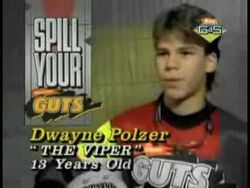
After the first event, one of the three players was asked to "Spill Your GUTS" between the remaining events. In season one, Mike talked about the player and his or her athletic and non-athletic interests. In season two, Moira discussed the player's interests, and also mentioned what GUTS equaled to that player. In season three, during a brief prerecorded segment, players introduced themselves and revealed their athletic and non-athletic interests, what "having guts" meant to them, why they were excited to be on the show, and/or usually also give a shout-out to their friends and family back home. On Global GUTS, contestants introduced themselves; non-English speakers introduced themselves in their native language, and a translator did an English voice over for them.
Events[]
There were several different types of events, ranging from field sports to pool sports. Many events made use of elastic harnesses for aerial purposes. There were also track events and an obstacle course taking place in the gym.
Elastic/Aerial[]
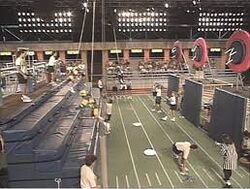
Bull's Eye
- Year of debut: 1992
- Objective: Modeled after archery, players were equipped with crossbows and velcro arrows. With the help of the elastics, they jumped off the Aerial Bridge and fired the arrows at the targets in front of them. Only arrows that actually hit the bullseye counted, and they only counted after the player hit the ground first before bouncing back up. The player with the most bullseyes scored in 60 seconds won the event (45 seconds in one season 3 episode). All three players competed at the same time.
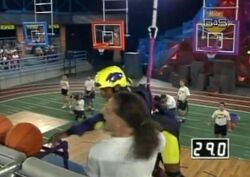
Slam Dunk
- Year of debut: 1992
- Objective: Players jumped off the Aerial Bridge and attempted to shoot a basketball through an elevated basketball hoop with each jump. Baskets only counted if they were made after the player touched the ground. All three players competed at the same time, and the player with the most baskets scored in 60 seconds won.
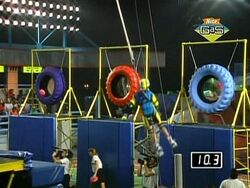
Spirals
- Year of debut: 1992
- Objective: With all three competing at the same time, players jumped off the Aerial Bridge and tried to throw footballs through a set of tires and into a net. Earlier playings of this event had six small tires (for each player) stacked on top of one another in a pyramid fashion, and later playings replaced the small tires with one large tire, colored after the player's color. The player with the most footballs thrown into his or her goal in 45 seconds (60 seconds in season 2) won.
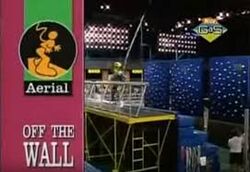
Off the Wall
- Year of debut: 1992
- Objective: 50 baseballs were attached to each of three walls. The players jumped off the Bridge and tried to knock as many baseballs as they could off the wall. The player with the most baseballs knocked off in 45 seconds won the event (this was usually determined by how many baseballs were left on the wall).
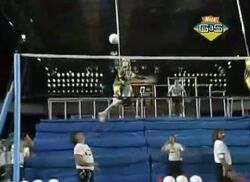
Spike It
- Year of debut: 1992
- Objective: Players jumped off the Bridge and tried to hit a volleyball over a net and onto a target on the ground. Each player received five serves. If the player had a false serve, they were allowed to take that serve over again. The player with the most volleyballs hitting the targets was the winner. On some occasions, players played the game one at a time; and at other times, all three players participated simultaneously.
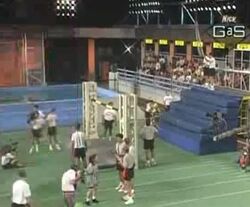
Over the Top
- Year of debut: 1992
- Objective: In this event, modeled after high jump competitions, each player, one at a time, jumped off the Aerial Bridge and tried to jump over a hurdle at a set height. Each player received three jumps (two in one episode). If a player successfully cleared the hurdle, it was raised for the next jump; if not, the player attempted the next jump at the same height. The player who jumped the highest was the winner. In the first two seasons, the heights they had to clear were 6'9", then 7'5", and 8'1". In season 3, the heights were raised to 8'8", 9'4", and 10'0". On Global GUTS, the heights were 2.5 meters, 2.75 meters, and 3 meters.
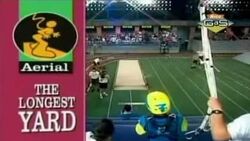
The Longest Yard
- Year of debut: 1992
- Objective: Modeled after long jump competitions, each player jumped from the Bridge and tried to make the longest distance they could away from it, making their mark by planting their feet in a sand pit in front of the bridge. Jumps that did not include two footprints in the sand did not count. The player making the longest jump won the event.
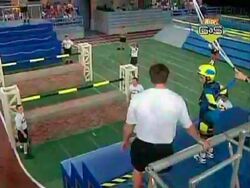
Jump! Jump!
- Year of debut: 1992
- Objective: This event was based on hurdling competitions. Players jumped off the bridge, over two high hurdles, and onto the bridge on the opposite side, before jumping over the hurdles again and back onto the original bridge. A five-second penalty was imposed on a player if he or she knocked a hurdle down, and in the first two seasons a two-second penalty was imposed if a player needed help from the spotters. The player who cleared this event in the fastest time won the event. In the third season this event was made more difficult in that the jumps were longer and the hurdles were higher, but the penalties for spotter assistance were eliminated.
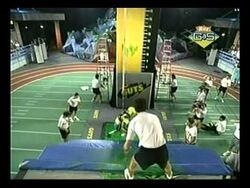
Make Your Mark
- Year of debut: 1992
- Objective: Each player jumped from the Bridge and, upon jumping back up, tried to make their highest mark on a yellow wall with paint resembling Nickelodeon's famous green slime. In earlier versions of this event, players put plastic gloves on their hands and dipped them in paint before trying to slap their hands on the wall. In later playings, players jumped into a giant ink pad (in season 1, players jumped into green ink, and in season 2, players jumped into inkpads corresponding to their jersey color) and then tried to make their mark on the wall with their feet. The highest jump won.
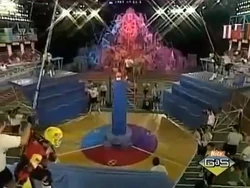
Rebound
- Year of debut: 1993
- Objective: A basketball was placed on a solitary cylinder in the middle of the arena floor. Here, players (who were in three different corners) jumped off their Aerial Bridges and to the center of the floor, and as they jumped up, they tried to grab the basketball and take it back to their bridge, which counted as a "rebound." There were seven attempts in this event (reduced to five in season 3, but changed back to seven in Global GUTS), and the player with the most rebounds won.
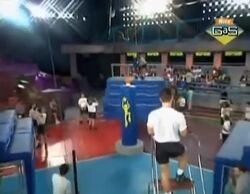
Jump Ball
- Year of debut: 1993
- Objective: The layout was the same as Rebound, except the floor was painted in 3 different sections - blue, red and purple. Here, when the players jumped off their bridges and to the cylinder, they would tip the basketball (the jump ball) to the floor. Whatever color section the basketball landed on, scored a point for the player of that particular color. There were seven chances in this event, and the player with the most jump balls landing in their colored section was the winner.
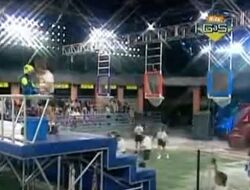
Attack
- Year of debut: 1993
- Objective: In this event, players were equipped with lacrosse sticks and a ball to go with it. After jumping off the bridge, each player used his or her lacrosse stick to try to throw the ball into an elevated net. The player with the most goals scored in 60 seconds won. All three players competed at the same time in this event.
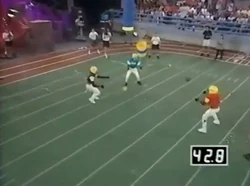
Fumble
- Year of debut: 1993
- Objective: The players were outfitted in football equipment and were hooked to one another with elastics around their waists, as they stood in three different corners. When a player traveled in one direction, he or she pulled another player with them due to the effect of the elastics. In the center of the field, a barrage of footballs fell out of a tube, and players had to recover the fumbles from the ground and put the footballs into their own baskets. The player with the most fumbles recovered in 45 seconds won. For Global GUTS, this event was renamed Scrumble, and each player now had to throw the footballs into his or her designated goal post instead of a basket and the event was timed at 60 seconds.
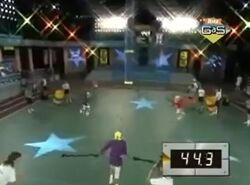
Rugby
- Year of debut: 1994
- Objective: This game was played the same as Fumble, but with rugby balls, and players wore rugby shirts instead of football jerseys.
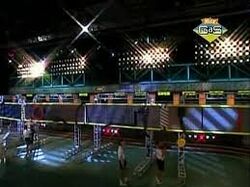
Zero G
- Year of debut: 1994
- Objective: The contestants were suspended sideways and had to run across a sideways track with hurdles and trampolines ("Black Holes"). They also had to make their way around the "Edge of Nothing," a sharp turn onto the other side of the track. The player who cleared this event in the fastest time was the winner.
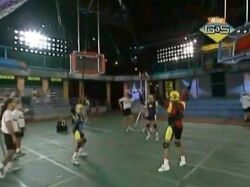
Touchdown
- Year of debut: 1994
- Objective: With elastics, the players bounced up and down as they stood in three different corners, with an elevated goal directly across from each player. Contestants were required to grab footballs from elevated racks next to them, then try to throw them into their corresponding goals. The winner was determined by who scored the most "touchdowns" in 45 or 60 seconds.
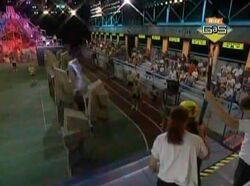
Peak to Peak
- Year of debut: 1994
- Objective: Eight miniature mountain peaks were laid out in the middle of the arena, alternating between left and right. With the help of the elastics, players jumped from the Aerial Bridge and went from one peak to another before reaching the opposite bridge and returning in the same manner. Players were assessed a two-second penalty if any peaks were missed. The player with the fastest time won.
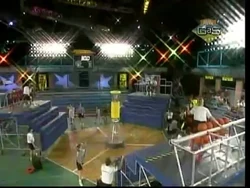
Slam-A-Jama
- Year of debut: 1994
- Objective: Each player had 30 seconds to score baskets in a hoop inside of a center cylinder while the other players tried to reject the shots. After one player has had their turn, he or she then went on defense against the next player. The player with the most hoops scored won. Players on defense could not grab onto the basket while they tried to defend against a player on offense; if they did grab onto the basket, they would lose a point that they scored on offense.
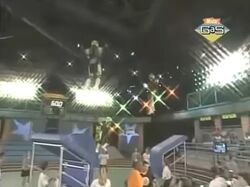
Dodge It
- Year of debut: 1994
- Objective: This event was modeled after the game of dodgeball. The players were in three corners as they bounced up and down constantly with the help of the elastics. As dodgeballs poured out of an elevated tube, players attempted to catch a ball and hit one of their opponents with it. Players were allowed to catch a dodgeball thrown at them (though it would still count as a hit against that player) and use it against the player that threw it, or against another player. The player who scored the most hits against their opponents in 60 seconds was the winner.
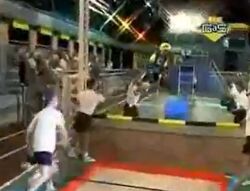
Triple Jump
- Year of debut: 1994
- Objective: One at a time, each player had two attempts (three in one episode) to jump onto an elevated platform, then over a set of barrels, and finally over a high hurdle before landing in a sand pit. The winner was the player with the furthest footprints from the aerial bridge, but attempts that did not result in both feet being planted in the sand (including not reaching the sand due to lack of momentum) were disqualified. Players were also disqualified if either they stepped over the foul line during their jump or if they failed to clear all of the obstacles.
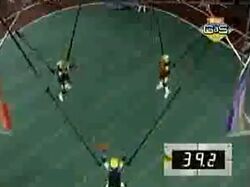
Double Play
- Year of debut: 1994
- Objective: This event was played similarly to the Touchdown event, except instead of footballs on elevated racks next to the players, baseballs were shot at the players from four different cannons. Each player had a fielder's glove on one hand, and had to catch the baseballs with their gloved hand before using their free hand to throw them into the elevated net directly across from them (which was referred to as turning the "double play"). The player with the most baseballs thrown into their goal in 60 seconds won.
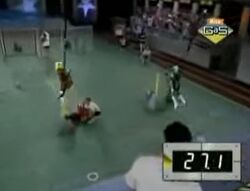
Shoot Out
- Year of debut: 1994
- Objective: Competing simultaneously, players jumped off their aerial bridges and tried to kick soccer balls into their own nets. The player who scored the most goals in 60 seconds won.
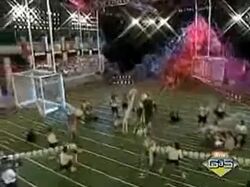
Skyball
- Year of debut: 1995
- Objective: Played like Touchdown and Double Play, but used balls that are seen in Dodge It that are shot at the players from cannons. The player with the most goals scored in 60 seconds won.
Gym[]
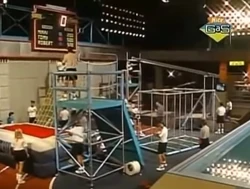
Basic Training
- Year of debut: 1992
- Objective: One of the most frequently played events, players navigated a six-station obstacle course (seven in Global GUTS) one at a time. To prevent making strategies based on his or her performance, opposing players were not allowed to watch contestants run the course before their turn. Players had to complete each obstacle before moving on to the next one (any missed or incomplete obstacle resulted in a disqualification). The player who cleared the course in the fastest time won. In the event of a false start, players would be allowed to start the course over once, but then a second false start in a row meant a disqualification. The obstacles, which varied every time the event was played, included one from each of the following stations:
- Obstacle 1:
- Obstacle 2 (falling off any of these made the player start the course over again, with the clock still running):
- Tightrope Walk: A chain-linked tightrope that players walked across to get to the next platform.
- Rings: A set of gymnastics-like rings that players used to swing across to the next platform.
- Tarzan Swing: A simple rope swing across the pit to the third obstacle on the next platform.
- Obstacle 3:
- Free Fall: Players jumped off the platform into an air bag with a bullseye target.
- Slide for Life: A 20-foot zipline ride halfway across the gym and onto a cushion in front of the fourth obstacle.
- Fire Pole: Players grabbed onto this obstacle and slid it down to the ground.
- Obstacle 4:

- Elastic Jungle: A jungle gym filled with elastic bands through which players had to walk or crawl.
- Tire Crawl: A set of hanging tires that the players had to jump into and crawl through.
- Obstacle 5:
- Wall Climb or Cargo Net, depending on which of those two obstacles was the first one
- Obstacle 6:
- Free Fall depending on whether or not it was the 3rd obstacle.
- Tube Slide: Players slid down this obstacle and landed in the GUTS pool.
- In Global GUTS, some new obstacles were added to this course, including:
- Slingshot: An inflatable slide that the players had to slide or jump down from.
- Pyramid: A set of barrels stacked in a pyramid fashion, which the players had to climb over.
- NOTES: The 1-hour GUTS All-Star Special (1993) included an extended version of this event, combining most of the obstacles into the same course. It started with the Tire Crawl and ended with a Slide for Life ride into the pool. Also, in Global GUTS, the Tightrope Walk was renamed Monkey Bridge.
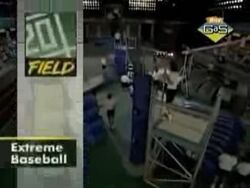
Extreme Baseball
- Year of debut: 1994
- Objective: Virtually identical to Basic Training; however, this event took on a baseball theme as the obstacles were set up in a diamond formation, with each completed obstacle ending on a "base path", complete with a baseball diamond placed on the landing mats. Done one at a time, the player who completed the course in the fastest time won the event. This event replaced Basic Training for the 1994 season.
Obstacles in Extreme Baseball included:
- Tarzan Swing (renamed in this event as the Ken Griffey, Jr. Swing)
- Fire Pole
- Tire Crawl
- Elastic Jungle
- Pyramid (known in this version as the Decoy Second Baseman)
- Column: A vertical column which players were required to climb to reach the elevated base.
- Free Fall
- Cargo Net
- Wall Climb to Third Base
- Slide for Life
- Tube Slide
(The above two were sometimes referred to as the Neon Deion Slide when used to land on Home Plate and conclude the run.)
Track[]
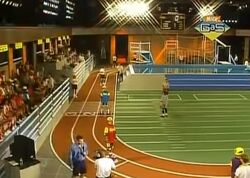
Moon Race
- Year of debut: 1992
- Objective: This event made use of Nickelodeon Moon Shoes, which were strapped to the players' feet. Players raced around the track by jumping with the moon shoes on. Players must stay in their designated lanes or they'll be disqualified, and the player who crossed the finish line first was the winner.
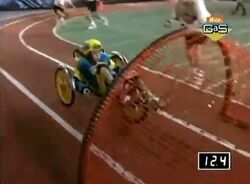
Wild Wheels
- Year of debut: 1992
- Objective: Players were buckled into a special recumbent tricycle, which they then pedaled around the track while going through some obstacles such as cones and ramps (and in later playings, the "Car Wash"). Players competed one at a time, and if the player went off the track or missed an obstacle during their run, he or she received a two-second penalty. The player who finished this course in the fastest time was the winner.
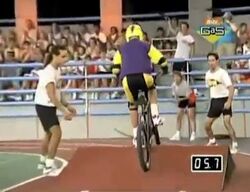
Eat My Dust
- Year of debut: 1992
- Objective: In this event, players, going one at a time, rode a BMX bicycle around the track, while having to deal with obstacles such as the "Bump n' Dump" ramp, a sand trap, the "Tippin' Tubular Tunnel", the "Sack Attack" (a series of swinging punching bags) and a final ramp before crossing the finish line. A two-second penalty was imposed on a player if they went off the track during their run. The fastest time was the winner.
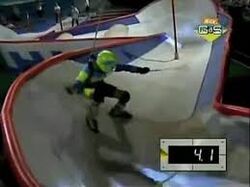
Blade Runners
- Year of debut: 1992
- Objective: The contestants wore in-line skates, which they used to race around the track, going through some obstacles as they went along, including a pair of low hurdles (the Limbo Bars), a series of flags or cones (the Frantic Flags, or the Slalom), some swinging punching bags (the Sack Attack), a low tunnel (the Car Wash), and a final ramp. Players received a two-second penalty if they stepped off of the track during their run. Fastest time won.
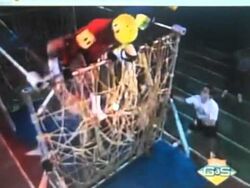
Tornado Run
- Year of debut: 1993
- Objective: In this event, the track had many different obstacles that the players had to navigate around, including running on top of a "river" (a simulated pond with stepping stones), then over a "rocking earthquake" (pieces of faux pavement that tilted up and down), after that scampering through and then climbing jungle vines (one set in early playings, and later two sets), and racing through a "swamp fog" on the final ramp. A wind also blew leaves onto the players during the race to make it more challenging. The more common version of this game had all three players run around the track, with the one crossing the finish line first being the winner. Alternate playings of this event had the players run through the course one at a time, with the winner being determined by the fastest time.
- Note: This is the only event where an injury occurred to a player that actually kept them out of the remainder of the competition. This happened in a Global GUTS episode (1995), where all three players fell after crossing the river, but one of them, CIS contestant Katya "The Asteroid" Afansjeva (in blue) sprained her ankle and was unable to continue on in the GUTS competition (she was then replaced by fellow Ukrainian, Stepan "The Serpent" Serdyuk). From that point on, players competed individually in Tornado Run.
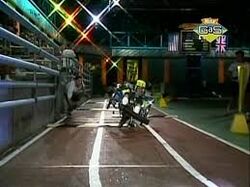
Mad Max
- Year of debut: 1993
- Objective: Played like Wild Wheels (with a reclining tricycle), this event (likely inspired by the movie of the same name) had many obstacles to overcome. As they pedaled around the track, contestants passed "The Junkyard" (a part of the track with scrap lying on it), then navigated over a series of speed bumps, then raced through "Pothole Pass", and finally crashed through a "Dead End" wall on their way to the finish line. The two-second off-the-track penalty applied to this event as well. Fastest time was the winner.
Pool[]
In the first two seasons, the pool was located in the field, but in season 3, the pool was moved to the scoreboard area. Also in season 2, plexiglass was added in to avoid water splashing outside the pool.
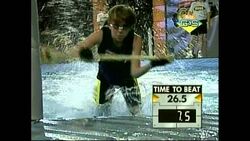
Invisible Boat
- Year of debut: 1992
- Objective: Players were hooked to an elastic cord and given a paddle. The players used the paddle to walk themselves across the pool before touching the end of the pool with their paddle; this was made more difficult by means of several water cannons creating rapids in the pool. Fastest time won. In the 1994 season, this event was made a bit more difficult, in that players were now required to paddle to the end of the pool and then back. As such, in this version of the event, not touching both ends of the pool with one's paddle resulted in a disqualification and an automatic third-place finish.
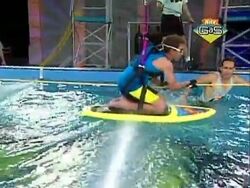
Boogie Down
- Year of debut: 1992
- Objective: With rapids active, players, who were hooked to a harness, use a rope to pull themselves from one end of the pool to the other and back while kneeling on a kneeboard (boogie board), high-fiving a spotter at each end to assure a complete run. Fastest time won the event.
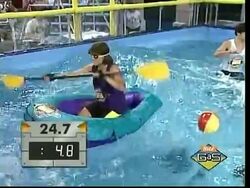
White Water
- Year of debut: 1992
- Objective: With rapids active, players had to paddle an inflated raft around two buoys and to the end of the pool, where they gave a high five to a spotter to end the race. If a player did not go around a buoy, he or she got a five-second penalty added to their time. The player with the fastest time won the event. In the first two seasons, if the player exceeded a 60-second time limit, he or she would get an automatic third place for running out of time. In season 3, the Wave Runner event (see below) was renamed to White Water. In Global GUTS, the Wave Ball would still be used, but the pylons were replaced by buoys again.
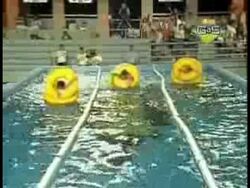
Totally Tubular
- Year of debut: 1992
- Objective: The swimming pool was divided into three lanes for this event, and each lane had an equal number of inner tubes. Players simultaneously swam to the other end of the pool, having to put the inner tubes over themselves as they swam along. After touching the end of the pool, they had to swim back to the starting point with the tubes still on them. The player who made it back to the starting point first was the winner. However, if a player did not touch the end of the pool before coming back to the starting point, or missed any inner tubes, he or she was disqualified.
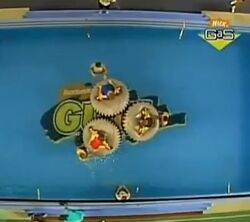
Splash Down
- Year of debut: 1992
- Objective: Three inflated tubes were attached to each other (with bungee cords) in a triangular fashion, with one player on each tube. With the rapids active, players shook the tubes with their bodies in an attempt to knock their opponents into the pool. The last player remaining above the water was the winner. This event was timed at 45 seconds, and if all three players stayed on top of their tubes, they all received first place points.
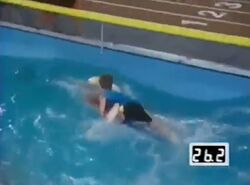
Hang Ten
- Year of debut: 1993
- Objective: While on a bodyboard (surfboard), players had 30 seconds to collect as many of ten buoys scattered around the pool as possible, while at the same time trying to battle against large waves created by a Wave Ball. In order for the buoys to count, they had to remain on the players' arms. Whoever collected the most buoys won.
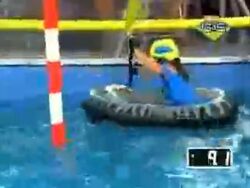
Wave Runner
- Year of debut: 1993
- Objective: This followed basically the same format as the White Water event, except that now, players had to make their way around two pylons, and instead of rapids, they would be hindered by waves caused by the Wave Ball. Again, fastest time won.
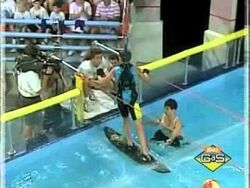
Power Ski
- Year of debut: 1993
- Objective: Hanging from a harness, the player's feet were strapped to a special (trick) water ski. With the Wave Ball active, the object was for the players to pull themselves from one end of the pool to the other and back while on the ski, high-fiving the spotters at each end. The fastest time won the event.
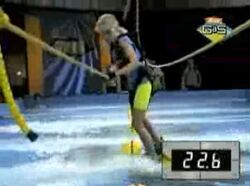
Skurfin' Safari
- Year of debut: 1994
- Objective: Strapped to a water ski (skurfboard), players had to pull themselves to one end of the pool and back in the rapids. However, five buoys were lined up in the player's path, and the contestant had to maneuver their way around the buoys in a slalom fashion in both directions, also having to high-five the spotter to end their attempt. Any time a player did not navigate around a buoy resulted in a two-second penalty. The penalty would also be imposed on any player who lifted their skurfboard out of the water for more than two seconds during their run. The player who cleared this event in the fastest time won.
Field[]
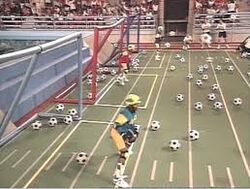
Free Kick
- Year of debut: 1992
- Objective: Two automated cannons shot several soccer balls at each of the players, who stood in front of each of three goal nets. Players had to block as many of the soccer balls as they possibly could in the allotted time (30 seconds in seasons 1 and 3, and 45 seconds in season 2 and Global GUTS), and the one who blocked the most shots won. If the player stepped outside of his or her own box, he or she was disqualified and given an automatic third-place finish.
Wild Pitch
- Year of debut: 1992

- Objective: Cannons shot several baseballs at high speeds directly at the three players. In earlier playings, the object of this game was to dodge as many balls as possible in 30 seconds, with the player getting hit the fewest times being the winner. The second and more familiar version of this event gave the players a baseball bat to use. Here, they tried to hit as many balls as they could with their bats in 30 seconds (45 seconds in season 2), with the winner being the person who hit the most balls. Players had to stay in their own boxes or else they would be disqualified. In season 1, the players were outfitted in catchers' gear, and in season 2, they wore batter's helmets, safety goggles, and protective chest pads.
Aces
- Year of debut: 1992

- Objective: Several cannons shot a series of tennis balls over a net at each player. Using a tennis racquet, the player had to return as many serves as possible back over the net in 30 seconds. The player with the most serves returned won.
Slap Shot
- Year of debut: 1994

- Objective: The field was divided into three separate lanes for this event. Each lane had barricades on alternating sides of the lane, and a revolving goal at the end of it. The players used a hockey stick, a pair of roller skates, and a ball for the puck; the object was to navigate around the barricades, keeping the ball in front of their stick, and try to score a goal by hitting the ball into the revolving goal. They would then skate back and repeat the process. The player with the most goals scored in 60 seconds (45 seconds in one episode) was the winner.
Blast It
- Year of debut: 1995

- Objective: Players stood in a center circle as soccer balls poured out of an elevated tube. There were three separate goals set in a triangular fashion outside the circle (each one representing the player's color), and the object was to score as many soccer goals as they could in 60 seconds. Players could not leave the center circle or touch the ball with their hands. Players who left the center circle were disqualified. The player with the most goals scored was the winner.
Ski slope[]
The events on the ski slope were considered to be part of the Aerial category on the show.
Vertiboggan
- Year of debut: 1994

- Objective: Modeled after tobogganing, each player (who was hooked to a harness) would navigate on a toboggan down a fabricated ski slope (which used soap bubbles to keep it slick), making some sharp turns (such as the "Nerve Curve" and the "Face Plant Slant") as they went along and passing through some moguls (known as "Mogul Mania"), until they reached the finish line. The player with the fastest time was the winner.
Spin Out
- Year of debut: 1994

- Objective: Players used a luge sled to make it down the ski slope and to the finish line, with the fastest time winning.
The Edge
- Year of debut: 1994

- Objective: Played like the other two Ski Slope events, this event had the players strapped to skis and using two ski poles for navigation down the slope. As always, fastest time would win.
The Aggro Crag[]
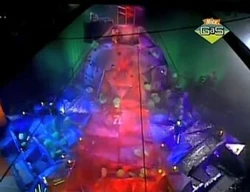
The fifth and final event, the Aggro Crag, later renamed the Mega Crag and finally the Super Aggro Crag, ultimately decided the winner. All three contestants raced to climb a fabricated mountain, activating a series of lighted targets commonly referred to as "actuators" (six and later seven in the first season; eight from the second season on) on their way to the peak. If a contestant missed an actuator along the way, that player could not complete the climb until he or she returned and activated the target they missed. The climb was made more difficult with special effects that simulated lightning storms, rock avalanches, flying "snow" in the form of glitter and confetti, "nuclear flying crystals", and steep walls. Each contestant had a separate but identical side of the mountain to climb, and was not permitted to cross into another's path. The first contestant to successfully activate each target, including the final one at the peak of the mountain, earned first-place worth 725 points. The second- and third-place contestants earned 550 and 375 points, respectively.
A number of violations on the Crag could result in a player being disqualified and automatically receiving third place points. These included:
- Inadvertently crossing into another player's section of the mountain, even by grabbing another player's hand rail
- Accidentally hitting someone else's actuator (excluding the final actuator)
- Making a false start at the beginning of the climb, i.e., beginning before the whistle
- Finishing the climb without lighting all of one's own actuators
- Not stepping on all of the boulders in the Crag's "Boulder Canyon" section at the base of the mountain, a rule introduced in the second season.
The increased point structure in the event allowed contestants to come from behind to win, despite earlier mistakes. It also nearly ensured that no two contestants could achieve a tie score. The only way two contestants could tie on the Crag was if they both violated the rules as outlined above and got disqualified for it. Although theoretically possible, a tie in the contestants' total scores never happened, even when two contestants were disqualified on the Aggro Crag.
The highest possible score for a contestant was 1925 points, and was attained several times throughout the show's run. Three contestants who achieved this score from the first season in 1992-93 were invited back to compete in a one-hour GUTS All-Star Special on August 21, 1993, to kick off the second season.
The Aggro Crag went through several revisions in the show's run, each longer and more difficult than the previous version. In the first two taped seasons (1992 and 1993), the mountain was called the Aggro Crag. For the show's third season in 1994, the mountain was renamed the Mega Crag. For the show's final season, Global GUTS (1995), it changed yet again to the Super Aggro Crag. In the third season in 1994, its color was changed to be molten.
The total height of the Aggro Crag is 28 feet.
It should be noted that the Aggro Crag was not actually made of rock, but out of foam and particle board. Thus, being awarded an actual piece of the rock was intrinsically impossible -- the winning contestant received the glowing trophy shown on camera.
Winning[]
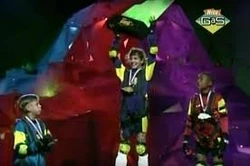
The player with the most points after all five events won the game and received a gold GUTS medal, as well as a faux glowing piece of the Aggro Crag. When the show changed to Global GUTS, the medals were redesigned to reflect the show's new logo. With all seasons of the show, second place received a silver medal and third received a bronze medal.
Trivia[]
- The show is basically a children's version of popular action show American Gladiators.
- Initially the scoreboards were fluorescent colors, but were changed to riveted metal as fashion trends changed in the mid nineties.
External links[]
| This page uses content from the English Wikipedia. The article or pieces of the original article was at Nickelodeon GUTS. The list of authors can be seen in the page history. As with Nickipedia, the text of Wikipedia is available under the GNU Free Documentation License. |
| Nickelodeon Games and Sports | |
|---|---|
| Double Dare • Finders Keepers • Total Panic • Think Fast • Make the Grade • Wild & Crazy Kids • Get the Picture • What Would You Do? • Nick Arcade • GUTS • Legends of the Hidden Temple • Figure It Out • You're On! • Sponk! • Robot Wars • Scaredy Camp • My Family's Got GUTS • BrainSurge • Webheads • Paradise Run • Keep It Spotless • Are You Smarter than a 5th Grader? • The Crystal Maze • Unfiltered • Unleashed • Tooned In | |




